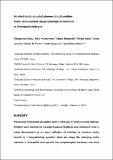Files in this item
An electrically coupled pioneer circuit enables motor development via proprioceptive feedback in Drosophila embryos
Item metadata
| dc.contributor.author | Zeng, Xiangsunze | |
| dc.contributor.author | Komanome, Yuko | |
| dc.contributor.author | Kawasaki, Tappei | |
| dc.contributor.author | Inada, Kengo | |
| dc.contributor.author | Jonaitis, Julius | |
| dc.contributor.author | Pulver, Stefan R. | |
| dc.contributor.author | Kazama, Hokto | |
| dc.contributor.author | Nose, Akinao | |
| dc.date.accessioned | 2022-10-17T23:39:35Z | |
| dc.date.available | 2022-10-17T23:39:35Z | |
| dc.date.issued | 2021-10-18 | |
| dc.identifier | 276340688 | |
| dc.identifier | d494e9a1-a480-4875-874b-7bf45176833e | |
| dc.identifier | 85120379409 | |
| dc.identifier | 000729218600006 | |
| dc.identifier.citation | Zeng , X , Komanome , Y , Kawasaki , T , Inada , K , Jonaitis , J , Pulver , S R , Kazama , H & Nose , A 2021 , ' An electrically coupled pioneer circuit enables motor development via proprioceptive feedback in Drosophila embryos ' , Current Biology , vol. In press . https://doi.org/10.1016/j.cub.2021.10.005 | en |
| dc.identifier.issn | 0960-9822 | |
| dc.identifier.other | RIS: urn:34C5ADF55F42DE49D0004CE235F0BC8F | |
| dc.identifier.other | ORCID: /0000-0001-5170-7522/work/101958937 | |
| dc.identifier.uri | https://hdl.handle.net/10023/26208 | |
| dc.description | This work was supported by KAKENHI Grant-in-Aid 19H04742, 18H05113, and 17H05554 to A.N.; 21H04789 and 18H02532 to H.K.; and 19J21596 (JSPS Fellows) to X.Z., and a grant from RIKEN to H.K. | en |
| dc.description.abstract | Precocious movements are widely seen in embryos of various animal species. Whether such movements via proprioceptive feedback play instructive roles in motor development or are a mere reflection of activities in immature motor circuits is a long-standing question. Here we image the emerging motor activities in Drosophila embryos that lack proprioceptive feedback and show that proprioceptive experience is essential for the development of locomotor central pattern generators (CPGs). Downstream of proprioceptive inputs, we identify a pioneer premotor circuit composed of two pairs of segmental interneurons, whose gap-junctional transmission requires proprioceptive experience and plays a crucial role in CPG formation. The circuit autonomously generates rhythmic plateau potentials via IP3-mediated Ca2+ release from internal stores, which contribute to muscle contractions and hence produce proprioceptive feedback. Our findings demonstrate the importance of self-generated movements in instructing motor development and identify the cells, circuit, and physiology at the core of this proprioceptive feedback. | |
| dc.format.extent | 7043428 | |
| dc.language.iso | eng | |
| dc.relation.ispartof | Current Biology | en |
| dc.subject | Central pattern generator | en |
| dc.subject | Motor development | en |
| dc.subject | Proprioceptive feedback | en |
| dc.subject | Gap junction | en |
| dc.subject | Pacemaking activity | en |
| dc.subject | QH301 Biology | en |
| dc.subject | DAS | en |
| dc.subject | AC | en |
| dc.subject.lcc | QH301 | en |
| dc.title | An electrically coupled pioneer circuit enables motor development via proprioceptive feedback in Drosophila embryos | en |
| dc.type | Journal article | en |
| dc.contributor.institution | University of St Andrews. School of Psychology and Neuroscience | en |
| dc.contributor.institution | University of St Andrews. Centre for Biophotonics | en |
| dc.identifier.doi | https://doi.org/10.1016/j.cub.2021.10.005 | |
| dc.description.status | Peer reviewed | en |
| dc.date.embargoedUntil | 2022-10-18 | |
| dc.identifier.url | https://www.sciencedirect.com/science/article/pii/S0960982221013592?via%3Dihub#app2 | en |
This item appears in the following Collection(s)
Items in the St Andrews Research Repository are protected by copyright, with all rights reserved, unless otherwise indicated.

